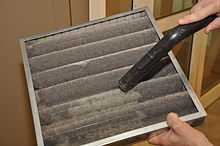
Back جودة الهواء الداخلي Arabic Qualitat de l'aire interior Catalan Ansawdd aer dan do Welsh Raumluftqualität German Calidad del aire interior Spanish Barneko aire kalitate Basque کیفیت هوای داخل ساختمان Persian Qualité de l'air intérieur French Ọnọdụ ikuku ime ụlọ IG Qualità dell'aria interna Italian

| Part of a series on |
| Pollution |
|---|
 |
Indoor air quality (IAQ) is the air quality within buildings and structures. Poor indoor air quality due to indoor air pollution is known to affect the health, comfort, and well-being of building occupants. It has also been linked to sick building syndrome, reduced productivity, and impaired learning in schools. Common pollutants of indoor air include: secondhand tobacco smoke, air pollutants from indoor combustion, radon, molds and other allergens, carbon monoxide, volatile organic compounds, legionella and other bacteria, asbestos fibers, carbon dioxide,[1] ozone and particulates. Source control, filtration, and the use of ventilation to dilute contaminants are the primary methods for improving indoor air quality.
IAQ is evaluated through collection of air samples, monitoring human exposure to pollutants, analysis of building surfaces, and computer modeling of air flow inside buildings. IAQ is part of indoor environmental quality (IEQ), along with other factors that exert an influence on physical and psychological aspects of life indoors (e.g., lighting, visual quality, acoustics, and thermal comfort).[2]
Employees working in indoor workplaces such as offices, retail stores, hospitals, libraries, schools and preschool childcare facilities can also be affected by poor IAQ. They may exhibit symptoms associated with sick building syndrome including burning of the eyes, scratchy throat, blocked nose, and headaches.[3]
Indoor air pollution is a major health hazard in developing countries and is commonly referred to as "household air pollution" in that context.[4] It is mostly relating to cooking and heating methods by burning biomass fuel, in the form of wood, charcoal, dung, and crop residue, in indoor environments that lack proper ventilation. Millions of people, primarily women and children, face serious health risks. In total, about three billion people in developing countries are affected by this problem. The World Health Organization (WHO) estimates that cooking-related indoor air pollution causes 3.8 million annual deaths.[5] The Global Burden of Disease study estimated the number of deaths in 2017 at 1.6 million.[6]
- ^ Carroll, GT; Kirschman, DL; Mammana, A (2022). "Increased CO2 levels in the operating room correlate with the number of healthcare workers present: an imperative for intentional crowd control". Patient Safety in Surgery. 16 (35): 35. doi:10.1186/s13037-022-00343-8. PMC 9672642. PMID 36397098.
- ^ KMC Controls (September 24, 2015). "What's Your IQ on IAQ and IEQ?". Archived from the original on April 12, 2021. Retrieved April 12, 2021.[unreliable source?]
- ^ Burge, P S (February 2004). "Sick building syndrome". Occupational and Environmental Medicine. 61 (2): 185–190. doi:10.1136/oem.2003.008813. PMC 1740708. PMID 14739390.
- ^ Bruce, N; Perez-Padilla, R; Albalak, R (2000). "Indoor air pollution in developing countries: a major environmental and public health challenge". Bulletin of the World Health Organization. 78 (9): 1078–92. PMC 2560841. PMID 11019457.
- ^ "Household air pollution and health: fact sheet". WHO. May 8, 2018. Archived from the original on November 12, 2021. Retrieved November 21, 2020.
- ^ Ritchie, Hannah; Roser, Max (2019). "Access to Energy". Our World in Data. Archived from the original on November 1, 2021. Retrieved April 1, 2021.
According to the Global Burden of Disease study 1.6 million people died prematurely in 2017 as a result of indoor air pollution ... But it's worth noting that the WHO publishes a substantially larger number of indoor air pollution deaths..